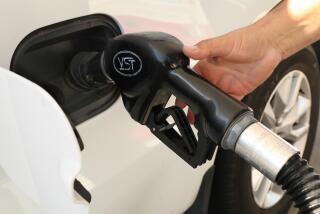Annuity Could Halve Exxon Settlement
- Share via
WASHINGTON — Exxon’s agreement to pay $1 billion to settle government claims and charges for the nation’s largest oil spill could actually cost the company less than half that amount, an Associated Press analysis shows.
The company’s cost would be reduced if it chose to purchase an annuity that would guarantee the 10 future annual payments called for under the settlement in the Exxon Valdez case--a growing business practice. Exxon’s cost would be further cut because most of the payments are tax deductible.
The AP calculations, based on an actual market quotation for an annuity, show it could cost Exxon as little as $486.3 million to meet its obligations to repair the damage caused when the supertanker ran aground and spilled 11 million gallons of crude oil in Alaska’s Prince William Sound in March, 1989.
In Houston, Exxon spokesman Bill Smith had no comment on the calculations or the current value of the settlement.
Last week, Atty. Gen. Dick Thornburgh proudly announced a $1-billion settlement by Exxon that included record criminal fines and civil damages.
But the settlement drew skepticism at a congressional hearing Wednesday. “In essence, a lot of taxpayers’ money is going back into this to pay Exxon’s share,” Rep. George J. Hochbrueckner (D-N.Y.) said at a House Merchant Marine Committee session.
The Congressional Research Service, using three different estimates of how much investments might earn over the next 10 years, calculated Exxon’s costs at between $421 million and $524 million in material prepared for the hearing.
At the request of The Associated Press, JMW Settlements Inc. of Washington, a national company that specializes in writing deferred payment settlements of lawsuits, calculated that it would charge Exxon $527.3 million for an annuity that would make $785 million in deferred payments. These payments begin next year and continue through 2001.
“I would be authorized to place that contract today,” said James P. Klapps, vice president of JMW. Klapps said the figure includes a profit for his company and two large insurance company underwriters.
An annuity, most often sold by insurance companies, is used to set deferred payments. It costs less to buy than the payments it provides, because the underwriter invests the original amount and uses the interest to meet the payments and make a profit.
In fact, Exxon could essentially save the amount of that profit by financing its own annuity internally.
Klapps said his industry has seen growing use of annuities in environmental cases to protect plaintiffs against the bankruptcy of a polluting company, but those cases have involved much smaller companies than Exxon.
In addition to the $527.3 million for the annuity, Exxon this year would have to spend $50 million to pay a federal criminal fine, $50 million in restitution to Alaska and an estimated $115 million on the first installment in the damages.
The $115-million figure includes $90 million due as soon as a federal court approves the settlement, plus $25 million that a high-ranking Justice Department source estimated Exxon will spend this year and next on cleaning the area.
The settlement provides that next year’s $150-million payment will be reduced by whatever Exxon spends this year and next. For the calculation, the AP assumed the $25 million estimated by the government source would all be spent this year. This assumption might overstate Exxon’s actual outlay by about $2 million if the company spread $25 million in cleanup over the full two years.
The payments would bring Exxon’s outlay to $742.3 million, but that figure could be reduced by tax deductions of up to $256 million, for a net outlay of $486.3 million.
More to Read
Sign up for Essential California
The most important California stories and recommendations in your inbox every morning.
You may occasionally receive promotional content from the Los Angeles Times.













